The switch captures the electrical difference between empty and full of material to detect the level. When material is empty, electrical status of detecting electrode and grounding electrode is: resistance (Ro) is infinite, and capacitance (Co) will be specific capacitance value determined by installation status.
Principles of detection by capacitance level switches
What principle does a capacitance level switch operate under? We receive this question often. This page explains the operating principle of a capacitance level switch in order to answer this question.We also advise customers who pose questions about capacitance level switches based on this principle.
Outline of a capacitance level switch
Principle of measurement of capacitance level switches
Principle of capacitance
Mathematical expression of capacitance
Additional functions of capacitance formulae
Outline of a capacitance level switch
You use the capacitance level switch after making a mounting hole in a vessel such as a tank or hopper, and insert an electrode into it.
When material touches the electrode, the level switch detect existence of material and output signal through a relay. The electrode can be installed in any orientation, horizontal, vertical, and slanted.
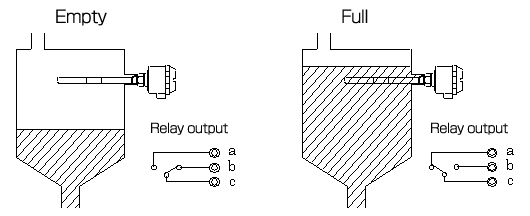
Principle of measurement of capacitance level switches
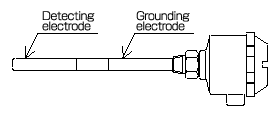
When the material is applied into a vessel, the electrode is filled (full status), resistance value and capacitance value between detecting electrode and grounding electrode changes to Rs and Cs. The switch captures this change and outputs.
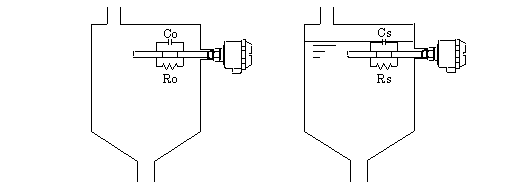
The electrical change varies with each material to be measured.
- If a material is not conductive (is isolative), the resistance is almost infinite and no change will occur.Only capacitance will change. The switch captures this change of capacitance and detects the level.
- If a material is conductive, the resistance value will be smaller. The switch captures this change of resistance and detects the level.
- There are semi-conductive substances that are neither isolative nor conductive. Semi-conductive substance change both resistance and capacitance. The switch captures these changes and detects a level.
Principle of capacitance
Metal plates are arranged in parallel and charge voltage and capacitance are generated.
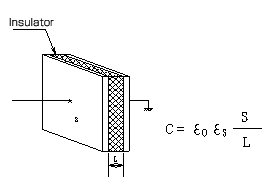
The capacitance value can be obtained by the following formula.
C is the capacitance value. e0 is the dielectric constant in a vacuum = 8.854×10-12. εs is the dielectric constant of the insulating substance. (εo is epsilon)
Capacitance of the metal plates is determined by metal plate area S, distance between the two plates L , and dielectric constant of isolative material between the two plates εs. Insulators have specific inductive capacity. For example, air has approximately 1.0 specific inductive capacity. General insulators have 2.0 to 5.0 specific inductive capacity. If S is equal to L, capacitance C changes according to specific inductive capacity of insulators. Namely, capacitance level switch detects and measure material by capturing change of capacitance value. Ground electrode and detection electrode of the level switch function same as these metal plates. Insulator between the metal plates roles material to measure to detect level.
If capacitance of insulator as air (material is empty) is 2PF, and when powder having dielectric constant 3.0 enters between the electrodes, capacitance will be 6PF. Therefore, the difference of capacitance is 4PF.
The capacitance level switch uses this principle (sensing changes of capacitance).
Mathematical expression of capacitance
Next, the principle of measurement of capacitance level switches will be described mathematically.
Suppose you insert a detection electrode of (Φ) 10 × 40mm into a 100mm metal electrode.
The vessel functions as a ground (figure 2 above).
1. If the vessel is empty, the capacitance can be obtained using the formula below.
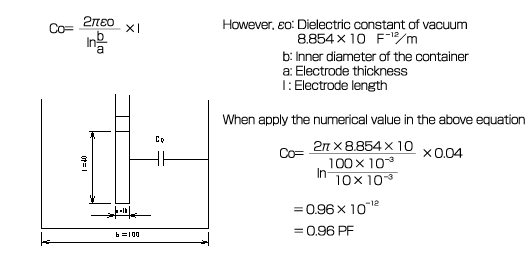
2. Next, put insulating liquid in the vessel, and you can get the capacitance using the formula below.
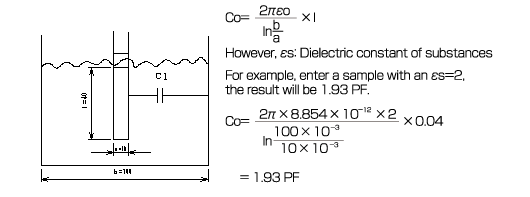
That is, the capacitance between when the vessel is empty and filled with liquid changes so the level can be detected.
Then, ΔC =C1-C0 =1.93-0.96 =0.97pF
Using the change above (ΔC=0.97pF), we can detect the presence of liquid.
Additional functions of capacitance formulae
In addition to the above basic principle, our capacitance level switch has other technologies applied to measure various materials and assess the actual measuring conditions.
We will suggest a meter that will suit you measured material (whether conductive or semi-conductive materials) and the measurement conditions, with an amplifier function for adhesion correction (that is, to cancel adhesion effects when material clings to the electrode). A lot of electrode types are available to match the strength and capacity of the material you want to measure.












